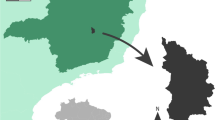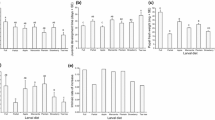Summary
Leaves from many misletoe species in Australia strongly resemble those of their hosts. This cryptic mimicry has been hypothesized to be a means of reducing the likelihood of mistletoe herbivory by vertebrates. Leaf Kjeldahl nitrogen contents (a measure of reduced nitrogen and thus amines, amino acids and protein levels) of mistletoes and their hosts were measured on 48 mimetic and nonmimetic host-parasite pairs to evaluate hypotheses concerning the significance of crysis versus noncrypsis. The hypothesis that mistletoes mimicking host leaves should have higher leaf nitrogen levels than their hosts is supported; they may be gaining a selective advantage through crypsis (reduced herbivory). The second hypothesis that mistletoes which do not mimic their hosts should have lower leaf nitrogen levels than their hosts is also supported; they may be gaining a selective advantage through noncrypsis (reduced herbivory resulting from visual advertisement of their reduced nutritional status).
Similar content being viewed by others
References
Barlow BA, Wiens D (1977) Host-parasite resemblence in Australian mistletoes: the case for cryptic mimicry. Evolution 31:69–84
Drummond J (1840) Swan River Journal. Hook J Bot 2:343–372
Ehleringer JR, Schulze E-D, Ziegler H, Lange OL, Farquhar GD, Cowan IR (1983) Xylem-tapping mistletoes: water or nutrient parasites? Science 227:1479–1481
Hensley WB (1896) Some remarkable phanerogamous parasites. J Linn Soc 31:306–311
Mattson WJ Jr (1980) Herbivory in relation to plant nitrogen content. Ann Rev Ecol Syst 11:119–161
Moore S, Le M (1899) The botanical results of a journey into the interior of Western Australia; with some observations on the nature and relations of the desert flora. J Linn Soc 34:171–251
Morrow PA, Fox LR (1980) Effects of variation in Eucalyptus essential oil yield on insect growth and herbivore load. Oecologia (Berlin) 45:209–219
Ullmann I, Lange OL, Ziegler H, Ehleringer JR, Schulze E-D, Cowan IR (1985) Diurnal courses of leaf conductance and transpiration of mistletoes and their hosts in central Australia. Oecologia (Berlin) 67:577–587
Author information
Authors and Affiliations
Rights and permissions
About this article
Cite this article
Ehleringer, J.R., Ullmann, I., Lange, O.L. et al. Mistletoes: a hypothesis concerning morphological and chemical avoidance of herbivory. Oecologia 70, 234–237 (1986). https://doi.org/10.1007/BF00379245
Received:
Issue Date:
DOI: https://doi.org/10.1007/BF00379245




